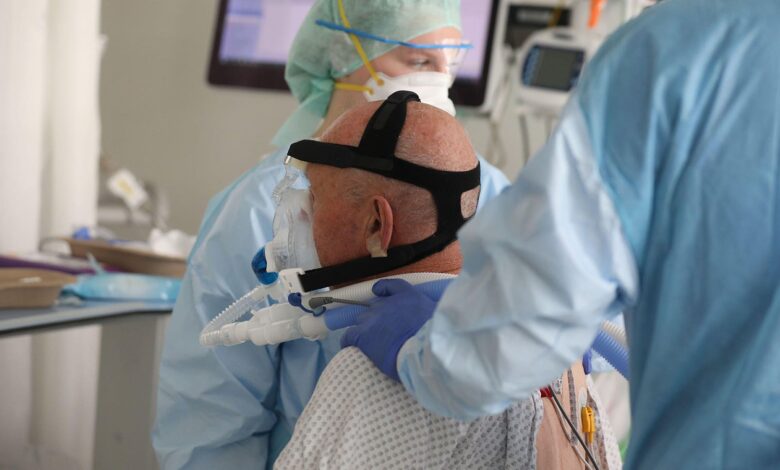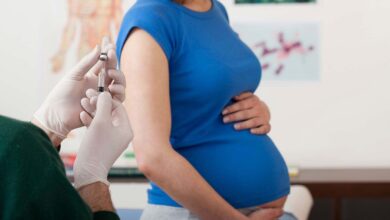Apnea Tied to Non-Invasive Ventilation in Hospitalized COVID Patients

— Booster vaccination blunted the risk, however
by
Elizabeth Short, Staff Writer, MedPage Today
April 9, 2024
In hospitalized veterans with COVID-19, obstructive sleep apnea (OSA) was associated with greater use of non-invasive ventilation (NIV), but booster vaccination reduced this risk, a retrospective study found.
While univariate analysis found higher odds of low- and high-flow oxygen use, NIV, and mechanical ventilation for COVID patients with OSA, only the link with NIV remained significant after adjustment for a host of potential confounders (OR 1.83, 95% CI 1.11-3.03), reported Bharati Prasad, MD, MS, of the University of Illinois at Chicago, and coauthors.
Across all of the hospitalized patients, a booster dose of COVID vaccine decreased both the likelihood of NIV (OR 0.58, 95% CI 0.35-0.99) and mechanical ventilation (OR 0.28, 95% CI 0.13-0.62), and that protective effect did not differ by OSA status, they wrote in the Annals of the American Thoracic Society.
As expected, use of pharmacological treatment for COVID-19 was associated with higher use of both high- and low-flow oxygen and NIV.
“This study adds to the current evidence and demonstrates that COVID-19 vaccine booster doses protect against acute respiratory failure progression with lower requirements for NIV and mechanical ventilation in an older, diverse population with OSA and other comorbidities,” wrote Prasad and co-authors.
“We postulate that the association of COVID-19 pharmacological treatment with higher use of low-flow and high-flow oxygen and NIV, noted in this study, reflects a COVID-19 treatment approach consistent with contemporary clinical guidelines,” they added.
Prior research has linked OSA with higher rates of COVID-19 infection and hospitalization, and more recently long COVID as well. And while numerous studies have demonstrated a protective dose-response benefit with COVID vaccination, data on patients with OSA has been limited, the researchers explained.
“A potential driving factor of these findings may be partly that OSA is associated with chronic intermittent hypoxia during the sleep period and systemic inflammation, which may potentially exacerbate COVID-19, affecting severity of initial infection as well as recovery,” said Catherine Heinzinger, DO, MS, of Cleveland Clinic’s Sleep Disorders Center, who was not involved in the study.
But the associations between OSA and higher oxygen use and hospital readmission rates were somewhat expected, she said, as “OSA is associated with comorbidities that are some of the common reasons for oxygen use, NIV, and hospital admissions — like heart failure, obesity, or pulmonary hypertension.”
For their study, Prasad and colleagues mined the Jesse Brown Veteran Affairs Medical Center COVID-19 registry in Chicago, and homed in on the 1,232 individuals hospitalized with COVID, of whom 452 had an OSA diagnosis.
Overall, men made up 95% of the population, most were Black (72%), and 19% were white. The OSA group was slightly younger on average (68 vs 69.6 years), with a higher mean BMI (31.7 vs 26.0), and had a lesser smoking history. Patients with OSA were also more likely to have received at least one dose of COVID vaccine (81% vs 74.5%) and three total doses (60.1% vs 51.9%).
Univariate analysis showed significantly more use of low-flow oxygen for patients with confirmed OSA versus non-OSA patients (59.5% vs 48.4%, respectively), NIV (11.4% vs 8.2%), and mechanical ventilation (9.4% vs 6%), but not high-flow oxygen. Furthermore, 30-day readmissions were also higher in the OSA group (21.6% vs 20.7%), according to the study. No significant differences were seen with regard to COVID severity, with severe disease in 17.6% of the OSA group and 15.2% of the non-OSA group and deaths in 6.8% and 5.8%, respectively.
Models that adjusted for age, BMI, smoking, and Elixhauser index still showed significant associations with OSA and higher use of low-flow oxygen (OR 1.61, 95% CI 1.24-2.09) and 30-day readmission (OR 1.74, 95% CI 1.24-2.43), but only the link between OSA and NIV remained after accounting for positive airway pressure (PAP) adherence and receipt of COVID vaccination or treatment.
“It is not surprising that these results attenuate with adjustment — we see this happen in a lot of studies due to the nature of OSA,” Heinzinger told MedPage Today. “It can be affected by so many different comorbidities and behaviors and it is difficult to account for all confounders.”
Limitations cited by the researchers included a lack of quantitative data regarding patients’ OSA severity and PAP device download data “due to the restrictions posed by the pandemic and PAP device recall and shortage during the study period.” Vaccination records after a third dose for COVID-19 were also unavailable.
-
![author['full_name']](https://clf1.medpagetoday.com/media/images/author/EShort_188.jpg)
Elizabeth Short is a staff writer for MedPage Today. She often covers pulmonology and allergy & immunology. Follow
Disclosures
This study was supported by funding from the Department of Veterans Affairs Clinical Science Research and Development, the Department of Veterans Affairs Health Services Research and Development, the Department of Veterans Affairs, and the Department of Housing and Urban Development.
No disclosures were reported by the study authors or Heinzinger.
Primary Source
Annals of the American Thoracic Society
Source Reference: Prasad B, et al “Impact of obstructive sleep apnea on health outcomes in veterans hospitalized with COVID-19 infection” Ann Am Thorac Soc 2024; DOI:10.1513/AnnalsATS.202309-831RL.

